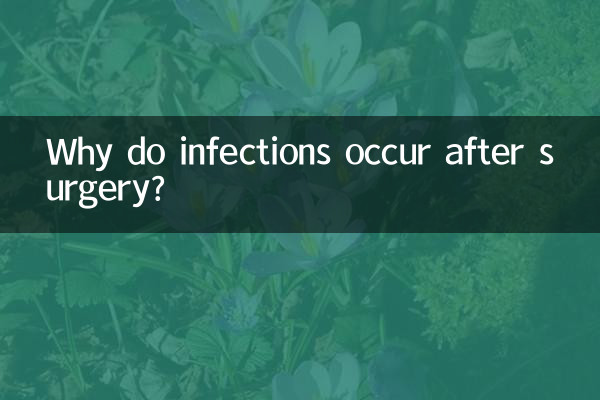Why do postoperative infections occur?
Postoperative infection is one of the common complications after surgery, which not only affects the patient's recovery, but may also increase medical costs and even threaten life. So, why do postoperative infections occur? This article will analyze the causes of infection, high-risk factors, preventive measures, etc., and combine it with recent hot topics to help readers fully understand this issue.
1. Main causes of postoperative infection

The occurrence of postoperative infection is usually related to the following factors:
| Cause of infection | Specific instructions |
|---|---|
| Surgical environment is not up to standard | Incomplete disinfection of the operating room, insufficient air cleanliness, or unqualified instrument sterilization may lead to bacterial infection. |
| patient factors | Underlying diseases such as low immune function, diabetes, and obesity increase the risk of infection. |
| Improper surgical procedure | Infection may occur if the operation time is too long, the incision is improperly handled, or the drainage tube is not taken care of properly. |
| Antibiotic abuse | Irrational use of antibiotics before and after surgery may lead to drug-resistant bacterial infections and increase the difficulty of treatment. |
2. High-risk groups for postoperative infection
Certain patient groups are more likely to develop postoperative infections. Here are the statistics for those at higher risk:
| high risk groups | Increased risk of infection |
|---|---|
| Seniors (over 65 years old) | 30%-50% higher than young people |
| diabetics | 2-3 times higher than non-diabetic patients |
| Obese patients (BMI≥30) | The risk of infection increases by 40%-60% |
| People who use immunosuppressants for a long time | Increased risk of infection by 50%-70% |
3. How to prevent postoperative infection?
Preventing postoperative infection requires multi-faceted efforts, including the cooperation of hospitals, doctors and patients:
1.Strict operating room management: Ensure that surgical instruments are sterilized and the air cleanliness in the operating room meets standards.
2.Assess the patient's condition before surgery: Take additional protective measures for high-risk patients, such as controlling blood sugar and strengthening nutritional support.
3.Rational use of antibiotics: Use antibiotics according to guidelines to avoid misuse leading to drug resistance.
4.Post-operative care in place: Keep the wound clean and change dressings regularly to avoid cross-infection.
4. Recent hot topics: public concern about postoperative infection
Recently, discussions about postoperative infection have become more popular on social media. The following are hot topics in the past 10 days:
| hot events | focus of discussion |
|---|---|
| Postoperative infection broke out in a hospital | Improper disinfection of surgical instruments led to infections in many patients |
| Experts call for strengthening antibiotic management | The issue of drug resistance in postoperative infections has attracted widespread attention |
| Application of AI technology in infection prediction | How artificial intelligence can help reduce postoperative infection rates |
| Patient rights protection case for postoperative infection | How to protect patients’ rights through legal means |
5. Summary
The occurrence of postoperative infection involves many factors, including the medical environment, patient constitution, and surgical procedures. Through scientific management and standardized operations, the risk of infection can be significantly reduced. Recently, public attention on postoperative infections has increased, which also reflects the importance of medical safety and patient rights. In the future, with the advancement of medical technology and improvement of management, the problem of postoperative infection is expected to be further controlled.
If you or a family member are about to undergo surgery, it is recommended to communicate with your doctor in advance about the risk of infection and strictly follow post-operative care instructions to minimize the possibility of infection.

check the details

check the details